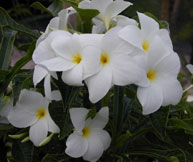|
 |
|
Esta página no está disponible en español. THE SO FL SUN-SENTINEL Frangipani A Flurry Of Flowers And Foliage By Robert Haehle November 7, 2003
Instead of the long, pointed leaves typical of the frangipani group, this plant has lobed foliage. Most of the rest of the clan drop leaves in October and are bare till about April, but this frangipani is an evergreen. A sun lover, it will grow to about 15 to 20 feet in height and width over time. It appears to be more upright growing in youth than the typical frangipani. The stems are less fleshy and I expect propagation will be more difficult. Young potted plants definitely do not do justice to the tree. They look gawky and leggy and you could easily pass them over. But plant this tree in the ground and the rewards will be worth the time. It grows quite dense and the wood is a bit brittle. Thinning out is essential to establish a strong framework that will resist wind. We recently had to thin out a tree that had grown almost top heavy with vigorous dense growth and abundant flowers. I have seen mealy bug on this plant but no rust. It should be relatively trouble-free most of the time. The one drawback: Unlike the typical frangipani, it has a minimal fragrance. Sources include: Jesse Durko's Nursery, 5151 SW 70th Ave., Davie, 954-792-2297; Natural Selections Exotics, 1401 SW 1st Ave., Fort Lauderdale, 954-523-2428; Tradewinds South, 3812 SW 48th Ave., Pembroke Park, 954-989-7617. Origin -- Puerto Rico. Foliage -- Large lobed evergreen leaves. Growth rate -- Moderate to fast. Nutritional requirements -- Low to moderate. Soil requirements -- Wide tolerance of various soil types. Avoid damp locations. Salt tolerance -- Moderate. Drought tolerance -- Moderate. Light requirements -- Sun. Propagation -- Cuttings. Major problems -- Mealybugs. Environmental problems -- None.
|

 Puerto Rican Frangipani (Plumeria pudica) is truly outrageous. The bloom clusters of white flowers can be as big as your head and almost look artificial. White flowers appear to glow at night, making this plant a sure way of finding your house in the dark.
Puerto Rican Frangipani (Plumeria pudica) is truly outrageous. The bloom clusters of white flowers can be as big as your head and almost look artificial. White flowers appear to glow at night, making this plant a sure way of finding your house in the dark.